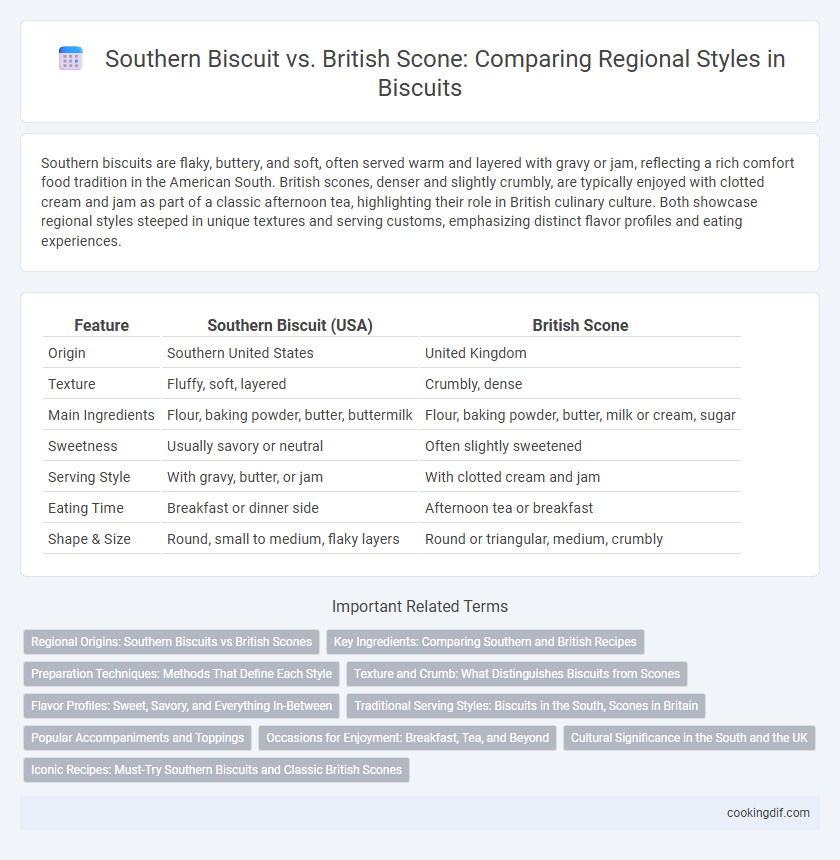Southern biscuits are flaky, buttery, and soft, often served warm and layered with gravy or jam, reflecting a rich comfort food tradition in the American South. British scones, denser and slightly crumbly, are typically enjoyed with clotted cream and jam as part of a classic afternoon tea, highlighting their role in British culinary culture. Both showcase regional styles steeped in unique textures and serving customs, emphasizing distinct flavor profiles and eating experiences.
Table of Comparison
| Feature | Southern Biscuit (USA) | British Scone |
|---|---|---|
| Origin | Southern United States | United Kingdom |
| Texture | Fluffy, soft, layered | Crumbly, dense |
| Main Ingredients | Flour, baking powder, butter, buttermilk | Flour, baking powder, butter, milk or cream, sugar |
| Sweetness | Usually savory or neutral | Often slightly sweetened |
| Serving Style | With gravy, butter, or jam | With clotted cream and jam |
| Eating Time | Breakfast or dinner side | Afternoon tea or breakfast |
| Shape & Size | Round, small to medium, flaky layers | Round or triangular, medium, crumbly |
Regional Origins: Southern Biscuits vs British Scones
Southern biscuits originate from the American South and are characterized by their flaky, buttery texture made with buttermilk and baking powder or soda, often served as a savory side or breakfast staple. British scones, rooted in British cuisine, have a denser crumb and are traditionally sweeter, commonly enjoyed with clotted cream and jam during afternoon tea. The regional origins highlight distinct cultural culinary traditions, with Southern biscuits emphasizing lightness and versatility while British scones focus on rich, slightly sweet flavors for social tea settings.
Key Ingredients: Comparing Southern and British Recipes
Southern biscuits typically feature all-purpose flour, buttermilk, baking powder, and sometimes baking soda, resulting in a flaky and tender texture with a slightly tangy flavor. British scones use self-raising flour, heavy cream or milk, and baking powder, creating a denser, crumbly texture often enriched with sugar or dried fruits for sweetness. The key difference lies in the leavening agent and fats: Southern biscuits rely on buttermilk and chemical leaveners for lift and moisture, while British scones emphasize cream and self-raising flour to produce a richer, more crumbly baked good.
Preparation Techniques: Methods That Define Each Style
Southern biscuits rely on the cold butter cutting method to create flaky layers, using buttermilk to activate leavening agents such as baking powder and baking soda. British scones emphasize a lighter, crumbly texture achieved by rubbing cold butter into flour until resembling breadcrumbs, followed by minimal handling to prevent toughness. The dough for Southern biscuits is typically rolled and folded multiple times, whereas scone dough is gently shaped and quickly baked to maintain its tender crumb.
Texture and Crumb: What Distinguishes Biscuits from Scones
Southern biscuits feature a tender, flaky texture with a soft, layered crumb achieved through the use of buttermilk and solid fats like butter or shortening. British scones have a denser, crumbly texture with a tighter crumb, often slightly sweetened and enriched with eggs and heavy cream. The key distinction lies in the biscuit's light, airy flakiness versus the scone's firm and more cake-like crumb structure.
Flavor Profiles: Sweet, Savory, and Everything In-Between
Southern biscuits feature a flaky texture with a buttery, slightly salty flavor that leans toward savory, often enhanced by buttermilk and baking powder. British scones tend to have a denser crumb and a subtly sweet taste, traditionally complemented by clotted cream and jam. Variations in ingredients and preparation methods between these regional styles create a diverse spectrum of flavor profiles, ranging from sweet to savory and everything in-between.
Traditional Serving Styles: Biscuits in the South, Scones in Britain
Southern biscuits are traditionally served warm and split open, often buttered or topped with gravy, reflecting their role as a savory breakfast staple in the American South. British scones, typically served with clotted cream and jam, are integral to traditional afternoon tea, emphasizing a sweeter, more delicate flavor profile. Both regional styles highlight distinct cultural rituals: Southern biscuits complement hearty meals, while British scones focus on refined tea-time elegance.
Popular Accompaniments and Toppings
Southern biscuits are famously paired with butter, honey, and sausage gravy, creating a savory and rich flavor profile deeply rooted in American Southern cuisine. British scones often accompany clotted cream and strawberry jam, highlighting a sweeter, tea-time tradition typically enjoyed with afternoon tea. These toppings reflect regional preferences, with Southern biscuits emphasizing hearty, comforting accompaniments and British scones showcasing delicate, fruity additions.
Occasions for Enjoyment: Breakfast, Tea, and Beyond
Southern biscuits, known for their flaky, buttery texture, are a staple at American breakfast tables, often paired with gravy, eggs, or sausage for hearty morning meals. British scones, lighter and slightly sweet, are traditionally served during afternoon tea, accompanied by clotted cream and jam, offering a refined and leisurely treat. Both baked goods transcend their regional roots, finding places in brunch menus, festive gatherings, and casual snacks, highlighting their versatility in diverse culinary occasions.
Cultural Significance in the South and the UK
Southern biscuits hold deep cultural significance in the American South as a symbol of hospitality and traditional home cooking, often served warm with gravy or butter during family gatherings. British scones, integral to the UK's tea culture, represent a refined afternoon ritual, typically enjoyed with clotted cream and jam. Both baked goods reflect regional identities, with Southern biscuits emphasizing comfort and communal meals, while British scones highlight elegance and tea-time social customs.
Iconic Recipes: Must-Try Southern Biscuits and Classic British Scones
Southern biscuits offer a flaky, buttery texture with iconic recipes like Grandma's Buttermilk Biscuits and Cheddar Chive Biscuits, embodying the rich tradition of the American South. British scones, renowned for their crumbly yet tender consistency, feature classic recipes such as Cream Tea Scones served with clotted cream and jam, reflecting the elegance of British teatime. Both regional styles highlight distinct baking techniques and flavor profiles that celebrate their cultural heritage.
Southern biscuit vs British scone for regional style Infographic

 cookingdif.com
cookingdif.com